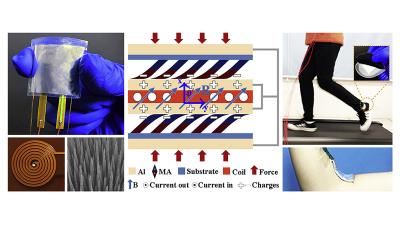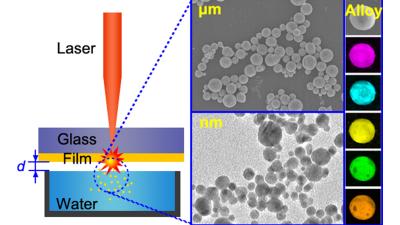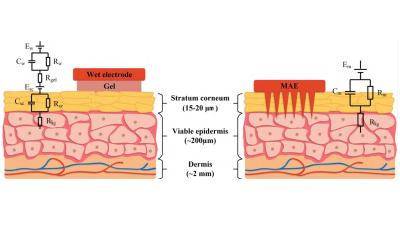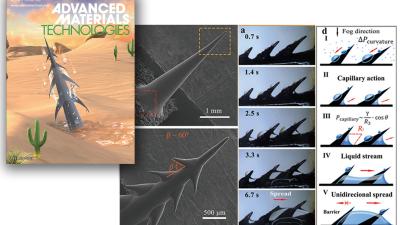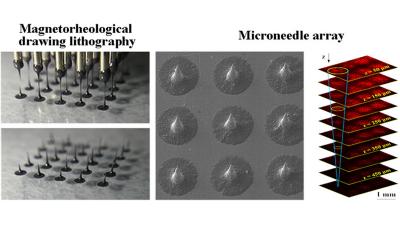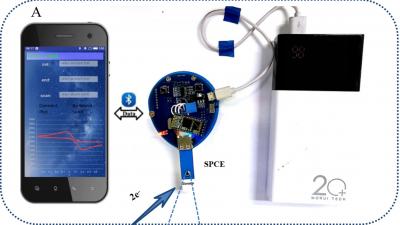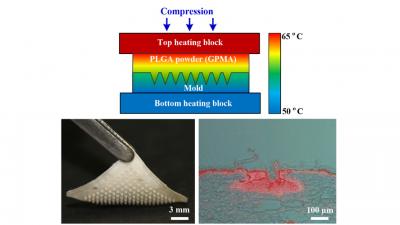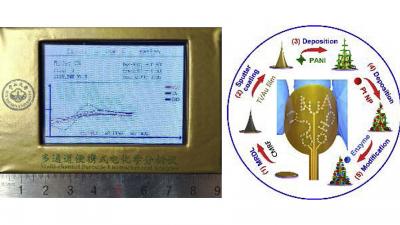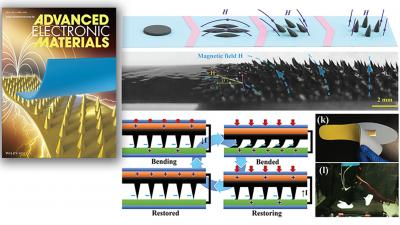2019
A Magnetized Microneedle-Array Based Flexible Triboelectric-Electromagnetic Hybrid Generator for Human Motion Monitoring
《Nano Energy》 Yuanyuan Li#, Zhipeng Chen#, Guizhou Zheng, Wenhao Zhong, Liyuan Jiang, Yawen Yang, Lelun Jiang*, Yun Chen, Ching-Ping Wong* 原文链接:https://doi.org/10.1016/j.nanoen.2019.104415 Abstract Most triboelectric-electromagnetic hybrid generators (TEHGs) are not suitable for monitoring human motions as wearable self-powered sensors owing to the rigid, complicated and bulky structures. In this work, we developed a novel magnetized microneedle-array (MA) based flexible TEHG for monitoring human motions. The magnetic-field-induced spray self-assembly method with electro-magnetizing technique was firstly proposed to cost-effectively fabricate magnetized microneedles for TEHG. The magnetized microneedles in TEHG simultaneously serve as the frictional layer of triboelectric generator (TEG) and bendable magnetic poles of electromagnetic generator (EMG). TEG utilized the closed bending-friction-restoring behavior of microneedles to generate triboelectricity while EMG used the rotation of magnetized microneedles to produce the induced electromotive force. TEG could output the open-circuit voltage (VOC) of 10 V and the EMG could generate the short-circuit current (ISC) of 80 μA under the 30 N and 1 Hz compressing-releasing operations. We demonstrated that the MA-based TEHG, integrated in insole and attached on elbow as the self-powered sensors, could exactly detect triggering frequency of human motions. Considering the unique advantages, including flexibility, small dimension, light weight, and easy scale up, further applications of TEHG in wearable electronics, self-powered sensors, and healthcare monitoring system are promising. Keywords:Triboelectric generator; Electromagnetic generator; Hybrid generator; Magnetic-field-induced spray self-assembly; Microneedle array
Rapid synthesis of metallic and alloy micro/nanoparticles by laser ablation towards water
《Applied Surface Science》 504 (2020) 144461 Zi Lin, Jun Yue, Liang Liang, Biao Tang, Bin Liu, Lei Ren, Yan Li, Lelun Jiang* 原文链接:https://doi.org/10.1016/j.apsusc.2019.144461 Abstract A versatile method named laser ablation towards water (LATW) was developed to rapidly and simply synthesize metallic and alloy micro/nano particles, even high-entropy-alloy nanoparticles (NPs). A nanosecond pulsed laser beam passed through a transparent glass substrate, ablated its coated metallic film in the air or contacting with water, and synthesized a colloidal solution contained the micro/nano particles. In this study, Cu microparticles (MPs, Daverage = 1.8 μm), Cu MPs with Cu2O NPs, Cu2O NPs and Au NPs (Daverage = 9.5 nm) were successfully synthesized by the laser ablation of 10 μm Cu film in the air, 10 μm Cu film in the water, 200 nm Cu film in the water, 200 nm Au film in the water, respectively. The content of bimetallic NPs can be adjusted by the relative thickness ratio of bilayer film using laser ablation. Moreover, the ternary (Au-Ag-Cu), quaternary (Au-Ag-Cu-Pt), and quinary (Au-Ag-Cu-Pt-Ni) alloy NPs were also fabricated by the laser ablation of multilayer metallic film in the water. Therefore, LATW is a flexible technique for the high-effective synthesis of MPs, NPs, and various alloy NPs. Keywords:Laser ablation; Water; Microparticles; Nanoparticles; Alloy nanoparticles
A Mini Review of Microneedle Array Electrode for Bio-Signal Recording: A Review
《IEEE Sensors Journal》 VOL. 20, NO. 2, JANUARY 15, 2020 Lei Ren, Bin Liu, Wei Zhou, and Lelun Jiang* 原文链接:10.1109/JSEN.2019.2944847 Abstract Bio-signal recording is vital for human condition monitoring and early disease diagnosis. An electrode is a biosensorfor bio-signalcollection.The conventionalwet electrode is not suitable for long-term bio-signal recording owing to the gradual drying of the electrolytic gel and increase in the electrode-skin interface impedance. Microneedle array electrode is a dry electrode that can painlessly pierce skin, form a contact interface between the microneedles and skin tissue, eliminate the high impedance of stratum corneum, weaken the motion artifact, and accurately record bio-signalswithout skin preparation and application of electrolytic gel. This review focuses on the recently developed fabrication techniques, the mechanical performance, and bio-signal recording performance of microneedle array electrode. The microneedle array electrode is a potential electrode for long-term bio-signal recording, although progress is required in terms of safety and scaled-up manufacture. Keywords:Microneedlearray; electrode; micro-fabrication; penetration; fracture; electrode-skininterface impedance; electrocardiography; electromyography; electroencephalography
Cactus‐Inspired Conical Spines with Oriented Microbarbs for Efficient Fog Harvesting
《Advanced Materials Technologies》 2019, 1900727 Shengzhu Yi, Jian Wang, Zhipeng Chen, Bin Liu, Lei Ren, Liang Liang, Lelun Jiang* 原文链接:https://doi.org/10.1002/admt.201900727 Abstract In nature, cacti use conical spines with oriented microbarbs and hydrophilic trichomes as an effective fog harvesting system. However, the fabrication dilemma of complex cactus‐inspired conical spines with oriented microbarbs limits their applications. Here, a magnetorheological drawing lithography (MRDL) method is developed to additively manufacture 3D cactus‐inspired conical spines with/without oriented microbarbs on a superhydrophilic porous substrate for efficient fog harvesting. Cactus‐inspired conical spines with/without microbarbs exhibit spontaneous and continuous deposition, coalescence, transport, and absorption of fog water. The strategy of the cactus‐inspired conical spine with backward barbs on a superhydrophilic porous substrate can significantly speed up unidirectional transport of water drops and achieve a higher fog‐harvesting efficiency. These properties are mainly attributed to the cooperation effect of the Laplace pressure gradient generated from the conical shape of the spine and microbarbs, the capillary pressure arising from the concave meniscus between the spine and backward barbs, and the wettability of a superhydrophilic porous substrate. This robust strategy has tremendous potential for application in high‐efficient fog harvesting, liquid manipulation, and microfluidics. Keywords:cactus-inspired conical spines; fog harvesting; microbarbs; unidirectional transport
Rapidly Fabricated Microneedle Arrays Using Magnetorheological Drawing Lithography for Transdermal Drug Delivery
《ACS Biomaterials Science & Engineering》2019, 5, 10, 5506-5513 Zhipeng Chen, Rui Ye, Jingbo Yang, Yinyan Lin, Weihsian Lee, Jingwei Li, Lei Ren, Bin Liu and Lelun Jiang* 原文链接:https://doi.org/10.1021/acsbiomaterials.9b00919 Abstract Microneedle arrays (MAs) are among the most promising transdermal drug delivery systems in the last decades due to its minimally invasive nature, convenient operation, and first-pass-metabolism avoidance. However, most MA fabrication methods are difficult to operate, need multiple steps, or require expensive equipment. A novel magnetorheological drawing lithography approach was proposed to rapidly fabricate a flexible microneedle array (FMA) for transdermal drug delivery. A 3D structural liquid MA was drawn in one step from the droplets of curable magnetorheological fluid and maintained its shape under an external magnetic field. The liquid MA was subsequently solidified and sputter-coated with the Ti/Au film to fabricate FMA. FMA morphology, mechanical properties, and transdermal drug delivery performance in vitro were experimentally investigated. FMA consisted of a 5 × 5 cone-shaped microneedle array on a PET flexible substrate. FMA exhibited good strength and excellent penetration performance. It could easily penetrate into skin without breakage, creating microchannels for the promotion of skin permeability. Drugs could be well permeated and diffused in the skin along the microchannels created by FMA. Finally, a dissolvable microneedle array (DMA) was also fabricated by a micromolding technique using FMA as a master template. The DMA exhibited good dissolvable and permeable performance in the agarose block. Keywords:Flexible Dissolvable; Microneedle array; Magnetic field Drawing lithography; Penetration force; Fracture force; Transdermal drug delivery
Point-of-need detection of microcystin-LR using a smartphone-controlled electrochemical analyzer
《Sensors and Actuators B: Chemical》 294 (2019) 132–140 Tian Guan, Wenzheng Huang, Ningxia Xu, Zhenzhen Xu, Lelun Jiang, Mengting Li, Xiaoqun Wei, Yingju Liu, Xing Shen, Xiangmei Li, Changqing Yi**, Hongtao Lei* 原文链接:https://doi.org/10.1016/j.snb.2019.05.028 Abstract The development of rapid and in situ detection method for microcystin-LR (MC-LR) with portable, reliable, and easy to use devices are highly demanded, but it is still deficient. In this study, a portable and wireless point-ofneed detection system for microcystin-LR (MC-LR) quantitation was developed and validated. The whole system consisted of three main parts: screen printed carbon electrodes (SPCEs), smartphone-controlled electrochemical analyzer (SCEA), and Android's smartphone. The SCEA was a homemade ARM STM32 microcontroller-based electrochemical analyzer, which have similar performance compared with a commercially available electrochemical workstation. A smartphone installed with a user-friendly application was employed to control the analyzer, receive and analyze data, and display detection results in real-time. This system can accurately quantitate MC-LR in the range of 0.001–100 μg/L with a detection limit of 0.00011 μg/L, and the results were consistent with LC–MS/MS. In addition, a preliminary MC-LR contamination map was generated using this smartphone-based platform by measuring water samples at 6 reservoirs located in Pearl River Delta (Guangdong Province, China). The cost-effective, reliable and easy-to-use smartphone-based detection system reported here can facilitate active toxicant screening to guarantee the safety of the drinking water, particularly in resourcelimited area. Keyword:Electrochemical immunosensor; Microcystin-LR; Point-of-need; Smartphone; ARM STM32 microcontroller
A smartphone-based quantitative detection device integrated with latex microsphere immunochromatography for on-site detection of zearalenone in cereals and feed
《Sensors & Actuators B: Chemical》 290 (2019) 170–179 Xiangmei Li, Jin Wang, Changqing Yi, Lelun Jiang, Jinxiao Wu, Xiaomin Chen, Xing Shen, Yuanming Sun, Hongtao Lei* 原文链接:https://doi.org/10.1016/j.snb.2019.03.108 Abstract In our study, a 3D printed smartphone-based detection device integrated with solid phase latex microsphere immunochromatography platform (SIAP) is developed for sensitive and quantitative detection of zearalenone (ZEN) in cereals and feed. A user-friendly Android application (App) is self-written to analyze, report and share the detection results. The cut-off values of latex microsphere immunochromatography for ZEN in cereals and feed were 2.5 and 3.0 μg/kg, respectively. The SIAP detection system can quantitatively detect ZEN in cereals and feed with the detection limits of 0.08 and 0.18 μg/kg, respectively. The recovery rates of corn, and feed samples were between 92.0%–105.0%, and 86.0%–107.5%, respectively, with the coefficient of variation ranging from 2.7% to 8.9%, and 7.8 to 10.9%, respectively. The detection results of real samples showed that there were differences in the content of ZEN in different feed ingredients and compound feed in China in October 2018, among which corn and wheat were still the feed ingredients with the most serious ZEN contamination, and it also demonstrated that the established SIAP detection system was reliable, portable, and user-friendly. This smartphone-based detection system will be popularized for on-site monitoring of various hazard factors such as veterinary drugs, antibiotics, illegal additives, etc. Keywords:Smartphone; Latex microspheres; Zearalenone; On-site; Cereals; Feed
Fabrication of gradient porous microneedle array by modified hot embossing for transdermal drug delivery
《Materials Science and Engineering: C》 Volume 96, March 2019, Pages 576-582 Jiyu Lia, Yingying Zhou, Jingbo Yang, Rui Ye, Jie Gao, Lei Ren, Bin Liu, Liang Liang, Lelun Jiang⁎ Abstract A gradient porous microneedle array (GPMA) is developed for transdermal drug delivery. A modified hot embossing approach is proposed to fabricate the GPMA from poly (lactic-co-glycolic acid) powders within a cavity array mold under the coupling combination of gradient thermal and pressure multi-fields. The porosity of the microneedles is a gradient, and the pores are mainly distributed in the tip region. The liquid drug formulation can directly be loaded in the pores of the microneedle tips by dipping. GPMA could penetrate into the rabbit skin without breakage and the penetration force per microneedle is approximately 22 mN. The GPMA can diffuse a dry model drug, namely Rhodamine B, in vitro in the rabbit skin dermis. The GPMA can also effectively deliver an insulin solution in vivo in diabetes rats, lowering the blood glucose levels. Above all, as a dry or liquid drug carrier and a minimally invasive injector, the GPMA offers an effective alternative for transdermal drug delivery. Keywords Porous; Microneedle array; Hot-embossing; Penetration; Transdermal drug delivery; Diabetes; Insulin
Simultaneous detection of glucose, uric acid and cholesterol using flexible microneedle electrode array-based biosensor and multi-channel portable electrochemical analyzer
《Sensors and Actuators B: Chemical》 Volume 287, 15 May 2019, Pages 102-110 JieGao, WenzhengHuang, ZhipengChen, ChangqingYi*, LelunJiang* 原文链接:https://doi.org/10.1016/j.snb.2019.02.020 Abstract The development of versatile and low-cost biosensor system for rapid and simultaneous detection of multiple blood metabolites is highly demanded for home healthcare. We developed a flexible microneedle electrode array-based biosensor (MEAB) and a multi-channel portable electrochemical analyzer (MPEA) for the simultaneous detection of glucose, uric acid, and cholesterol. Microneedle electrode array (MEA) was fabricated on the flexible substrate using magnetorheological drawing lithography, followed by sputter coated with Au/Ti film. Then, through biofunctionalized with glucose oxidase, uricase and cholesterol oxidase, MEA was conditioned as a biosensor for simultaneous detection of glucose, uric acid and cholesterol. MEAB demonstrated excellent sensing performance with a wide linear range (glucose, 2–12 mM; uric acid, 0.1–1.2 mM; cholesterol, 1–12 mM), low detection limit (glucose, 260 μM; uric acid, 4 μM; cholesterol, 440 μM), and rapid response time (∼4 s). MPEA, a homemade ARM STM32 microcontroller-based electrochemical analyzer, was validated to be comparable to that of the commercial electrochemical workstation. MPEA integrated with flexible MEAB could accurately and simultaneously detect glucose, uric acid, and cholesterol levels in serum, and the results were consistent with the portable electrochemical device. The ease-of-use of the reported biosensor system will facilitate effective monitoring of blood metabolites at home. Keywords:Microneedle electrode array; Multiplexed detection; Glucose; Uric acid; Cholesterol; Multi-channel portable electrochemical; analyzer
Magnetization-Induced Self-Assembling of Bendable Microneedle Arrays for Triboelectric Nanogenerators
《Advanced Electronic Materials》 2019,1800785 Zhipeng Chen, Rui Ye, Weihsien Lee, Dianwen Jin, Yuanxi Zhang, Liyuan Jiang, Yilin Yang, Lei Ren, and Lelun Jiang* 原文链接:https://doi.org/10.1002/aelm.201800785 Abstract Since the invention of triboelectric nanogenerator (TENG) in 2012, it has become one of the most important innovations in energy conversion technologies. A flexible microneedle array (MA)-based TENG is proposed using the closed bending–friction–deformation behavior of MA for the mechanical energy harvest. A novel magnetization-induced self-assembling method is introduced to effciently fabricate the bendable MA for the TENG. The 3D structures of MA are continuously self-assembled from a moving film of curable magnetorheological fluid under the assistance of a rotating external magnetic field. The mass production of MA may be achieved using this method in a roll to roll manufacturing mode. A polyethylene film, MA coated with Cr/Au film, and polyethylene film coated with Al film are heatsealed from top to bottom as a MA-based TENG. Under an applied force of 26 N with a frequency of 1.5 Hz, the MA-based TENG generates an open-circuit voltage of up to 9 V and a short-circuit current of up to 12 μA, corresponding to the peak current density of ≈1.37 μA cm-2. The MA-based TENG is integrated in an insole of right shoe as an accurate pedometer, which exhibites an excellent energy harvest ability.

